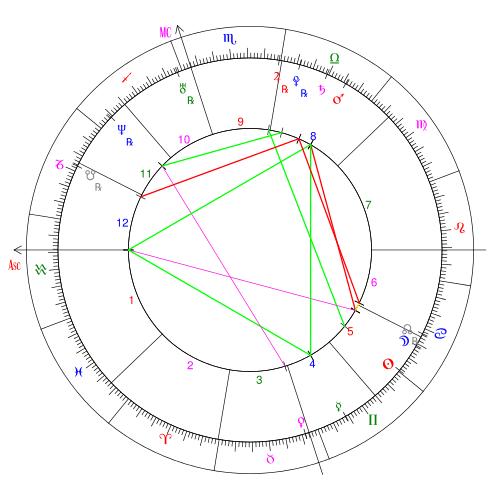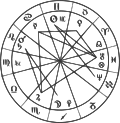Astrological aspect
In astrology, an aspect is an angle the planets make to each other in the horoscope, also to the ascendant, midheaven, descendant, lower midheaven, and other points of astrological interest. Aspects are measured by the angular distance in degrees and minutes of ecliptic longitude between two points, as viewed from Earth. According to astrological tradition, they indicate the timing of transitions and developmental changes in the lives of people and affairs relative to the Earth.
As an example, if an astrologer creates a horoscope that shows the apparent positions of the celestial bodies at the time of a person's birth (a natal chart), and the angular distance between Mars and Venus is 92° of arc, the chart is said to have the aspect "Venus square Mars" with an orb of 2° (i.e., it is 2° away from being an exact square; a square being a 90° aspect). The more exact an aspect, the stronger or more dominant it is said to be in shaping character or manifesting change.[1]

Approach
In medieval astrology, certain aspects, like certain planets, were considered to be either favorable (benefic) or unfavorable (malefic). Modern usage places less emphasis on these fatalistic distinctions. The more modern approach to astrological aspects is exemplified by research on astrological harmonics, of which John Addey was a major proponent, and which Johannes Kepler earlier advocated in his book Harmonice Mundi in 1619. But even in modern times, aspects are considered either hard (the 90° square, the 180° opposition) or easy (the 120° trine, the 60° sextile). The conjunction aspect (essentially 0°, discounting orb) can be in either category, depending on which two planets it is that are conjunct.
A list of aspects below presents their angular values and a recommended orb for each aspect. The orbs are subject to variation, depending on the need for detail and personal preferences.
Major aspects
The traditional major aspects are sometimes called Ptolemaic aspects since they were defined and used by Ptolemy in the 1st Century, AD. These aspects are the conjunction (0°), sextile (60°), square (90°), trine (120°), and opposition (180°). It is important to note that different astrologers and separate astrological systems/traditional utilize differing orbs (the degree of separation between exactitude) when calculating and using the aspects, though almost all use a larger orb for a conjunction when compared to the other aspects. The major aspects are those that can be used to divide 360 evenly and are divisible by 10 (with the exception of the semi-sextile).
Conjunction

A conjunction (abrv. Con) is an angle of approximately 0–10°. An orb of approximately 10° is usually considered a conjunction, but if neither the Sun nor Moon is involved, some consider the conjunction to have a maximum orb of only about 8°.
Conjunctions are said to be the most powerful aspect, mutually intensifying the effects of the planets involved; they are major point in an individual's chart. Whether the conjunction in question is regarded as beneficial or detrimental depends on the specific planets involved. In particular, conjunctions involving the Sun, Venus, and/or Jupiter, in any of the three possible conjunction combinations, are considered highly favourable, while conjunctions involving the Moon, Mars, and/or Saturn, again in any of the three possible conjunction combinations, are considered highly unfavourable.[2]
Exceptionally, the Sun, Venus, and Jupiter were in a 3-way (beneficial) conjunction on November 9–10, 1970, while on March 10 of that same year, the Moon, Mars, and Saturn were in 3-way (detrimental) conjunction.
If either of two planets involved in a conjunction is also under tension from one or more hard aspects with one or more other planets, then the added presence of the conjunction aspect will further intensify the tension of that hard aspect.
A planet in very close conjunction to the Sun (within 17 minutes of arc, or only about 0.28°) is said to be cazimi, an ancient astrological term meaning "in the heart" (of the Sun). For example, "Venus cazimi" means Venus is in conjunction with the Sun with an orb of less than ≈ 0.28°. Such a planetary position is a conjunction of great strength. A related term is combust, applicable when the planet in conjunction with the Sun is only moderately close to the Sun. In the case of combust, specific orb limit will depend on the particular planet in conjunction with the Sun.
The Sun and Moon experience a conjunction every single month of the year — during the New Moon.
Sextile — intermediate major/minor aspect
A sextile (abrv. SXt or Sex) is an angle of 60° (1/6 of the 360° ecliptic, or 1/2 of a trine [120°]). An orb between 3-4 is allowed depending on the planets involved.
The sextile has been traditionally said to be similar in influence to the trine, but less intense. It indicates ease of communication between the two elements involved, with compatibility and harmony between them. A sextile provides opportunity and is very responsive to effort expended to gain its benefits. See information on the semisextile below.
Square

A square (abrv. SQr or Squ) is an angle of 90° (1/4 of the 360° ecliptic, or 1/2 of an opposition [180°]). An orb of somewhere between 5° and 10°[3] is usually allowed depending on the planets involved.
As with the trine and the sextile, in the square, it is usually the outer or superior planet that has an effect on the inner or inferior one. The square's energy is strong and usable but has a tension that needs integration between 2 different areas of life, or offers a choice point where an important decision needs to be made that involves an opportunity cost. It is the smallest major aspect that usually involves houses in different quadrants.
Trine

A trine (abbrev. Tri) is an angle of 120° (1/3 of the 360° ecliptic), an orb of somewhere between 5° and 10° depending on the planets involved.
The trine relates to what is natural and indicates harmony and ease. The trine may involve talent or ability which is innate. The trine has been traditionally assumed to be extremely beneficial. When involved in a transit, the trine involves situations that emerge from a current or past situation in a natural way.
Opposition

An opposition (abrv. Opp) is an angle of 180° (1/2 of the 360° ecliptic). An orb of somewhere between 5° and 10°[3] is usually allowed depending on the planets.
Oppositions are said to be the second most powerful aspect. It resembles the conjunction although the difference between them is that the opposition is fundamentally relational. Some say it is prone to exaggeration as it is not unifying like the conjunction but has a dichotomous quality and an externalizing effect. All important axes in astrology are essentially oppositions. Therefore, at its most basic, it often signifies a relationship that can be oppositional or complementary.
Minor aspects
Quincunx (Inconjunct) — intermediate major/minor aspect
A quincunx is an angle of 150° (5/12 of the 360° ecliptic). An orb of ±3.5° is usually allowed depending on the planets involved. Unlike all the other aspects, it does not offer equal divisions of the circle.
Its effect is most obvious when there is a triangulating aspect of a 3rd planet in any major aspect to the 2 planets which are quincunx. Its interpretation will rely mostly on the houses, planets, and signs involved. The effect will involve different areas of life being brought together that are not usually in communication since the planets are far enough apart to be in different house quadrants, like the trine, but often with a shift in perspective involving others not previously seen clearly. Keywords for the quincunx are mystery, creativity, unpredictability, imbalance, surreal, resourcefulness, and humor.
Semi-sextile
A semi-sextile is an angle of 30° (1/12 of the 360° ecliptic). An orb of ±1.2° is allowed.
It is the most often used of the minor aspects perhaps for no other reason than it can be easily seen. It indicates a mental interaction between the planets involved that is more sensed than experienced externally. Any major aspect transit to a given planetary position will also involve the other planet that is in semi-sextile aspect to it. The energetic quality is one of building and potentiating each other gradually, but planets, houses and signs involved must be considered. Similar to a sextile in offering a quality of opportunity with conscious effort to benefit from.
Quintile
A quintile is an angle of 72° (1/5 of the 360° ecliptic). An orb of ±1.2° is allowed.
It indicates a strong creative flow of energy between the planets involved, often an opportunity for something performative, entertaining or expressive.
Septile
A septile is an angle of roughly 51.5° (1/7 of the 360° ecliptic). An orb of ±1° is allowed. It is the only prime number aspect that is an inexact number.
It is a mystical aspect that indicates a hidden flow of energy between the planets involved, often involving spiritual or energetic sensitivity and an awareness of finer and more subtle, hidden levels of reality involving the planets in septile aspect.
Semi-square
A semi-square is an angle of 45° (1/8 of the 360° ecliptic). An orb of ±2° is allowed.
It is an important minor aspect and indicates a stimulating or challenging energy like that of a square but less intense and more internal.
Novile
A novile is an angle of 40° (1/9 of the 360° ecliptic). An orb of ±1° is allowed.
It indicates an energy of perfection and/or idealization.
Declinations
The parallel and antiparallel (or contraparallel) are two other aspects which refer to degrees of declination above or below the celestial equator. They are not widely used by astrologers.
- Parallel: same degree± 1-degree 12-minutes of arc. This may be similar to a semi-square or quincunx in that it is not clearly seen. It represents an opportunity for perspective and communication between energies that requires some work to be made conscious.
- Contraparallel: opposite degree± 1-degree 12-minute of arc. Said to be similar to the parallel. (Some who use the parallel do not consider the contraparallel an aspect.)
See also
- Astrological symbols
- Hard aspect (astrology)
- Soft aspect (astrology)
- Applying aspect (astrology)
- Conjunction
- Opposition
- Cosmobiology
- Hamburg School of Astrology
References
- "The Aspects". Retrieved 2016-10-30.
- Buckwalter, Eleanor. "Depth analysis of the Astrological Aspects". Retrieved 2016-10-30.
- Orbs used by Liz Greene, see Astrodienst
External links
| Wikimedia Commons has media related to Astrological aspects. |
- The Classical Origin & Traditional Use of Aspects Deborah Houlding
- Online Ephemeris from Khaldea.com—600BC to 2400AD—Calculated for Midnight GMT; also with an Aspectarian included for years 1900 to 2005
